During the school exams, they would tell me to take a good night sleep after revision. They said it would help me remember better. When I was worked up about something, people told me to sleep on it. They said things would be better the next morning.
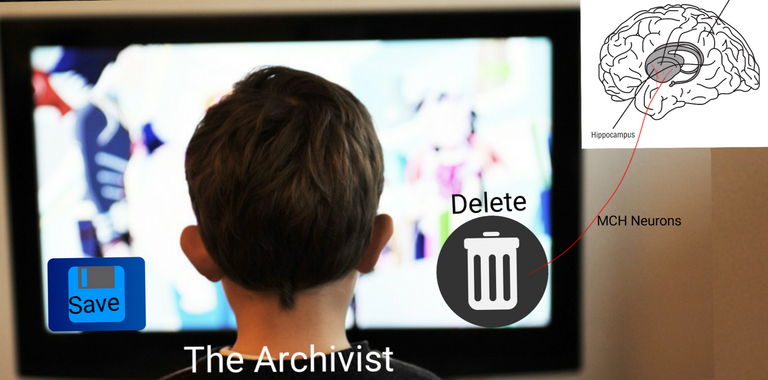
Using the following images -
Hippocampus by OpenClipart-Vectors
Save icon by peterolah0
Delete by Tabble
Child watching screen by mojzagrebinfo
Pixabay License
Illustrated by @scienceblocks.
The paper
The paper we will discuss today is titled - REM sleep–active MCH neurons are involved in forgetting hippocampus-dependent memories. It was published by Izawa et al., from Thomas S. Kilduff's and Akihiro Yamanaka's labs. It was published on science on 20 sep 2019.
So what's the fuss about - Background.
It appears that when we sleep our memories undergo maintenance. Some memories are strengthened, while others are deleted. We don't know yet how and which memories are targeted to be strengthened and which are targeted to be forgotten. But a big part of this can be attributed to we don't know the cellular and molecular mechanisms of exactly what goes on in our dreams, during our sleep.
In a very old post of mine, I talked about how memories are replayed in a brain region called hippocampus. In fact, you can kind of even engineer dreams. That is if you associate a spatial task with a cue like a tone or smell, you can play the tone when the animal is asleep. And, the same pattern of neurons, which got activated when the animal was exploring some space, will be activated again. In fact, it has been shown that a novel task learnt by an animal is replayed in its sleep for hours (Giri et al., 2019). And, this replay is not only limited to animal models but has also been shown to occur in resting humans (Schuck and Niv, 2019).
It has been shown in humans and animals that replay during sleep helps in memory enhancement. That is to say that memories that are replayed get stronger (Rasch, 2018). It is believed that during sleep when the replay happens in the absence of sensory cues, the hippocampus replay help forms the memory engrams in other cortical parts of the brain. This changes the weak short term memory to strong long term memory (Jordan, 2016).
But, as I said before, not all memories are enhanced. When we sleep some are deleted as well. Francis Crick in 1983 suggested that we dream to forget. And, now evidence has accumulated that forgetting during sleep is perhaps also an important part of memory consolidation. Perhaps it works to reduce information overload (Feld and Born, 2017). Then Li et al., 2017 showed that there is indeed pruning of synapses (connections between neurons) in the hippocampus. They showed that while some synapses are selectively pruned others are selectively enhanced.
I know one of the burning questions this leads us to is - how does brain make a decision for which memories to keep and which to forget. There can be multiple parameters dictating this - for instance how well the memory was formed, to begin with, or how much positive or negative reward was associated with that memory (Schapiro et al., 2018, Michon et al., 2019). But, this still doesn't tell us how that decision is made in the brain at cellular levels. If we want to know how that decision is made, we need to know what neurons fire, how and when to make that decision.
Think of it this way - there is an archivist sitting in your brain that presses one button when it wants to store the memory and another when it wants it to be deleted. But understanding the mind of archivist can only be achieved if we know what buttons the archivist is pressing and when. In today's journal club I talk about the paper which has figured out one such button for forgetting. We will see what that button is and how they found it.
How did they find the button?
Mapping the input connections.
Inspiration used from image by Smittawiki | CC BY 3.0
Drawn by @scienceblocks
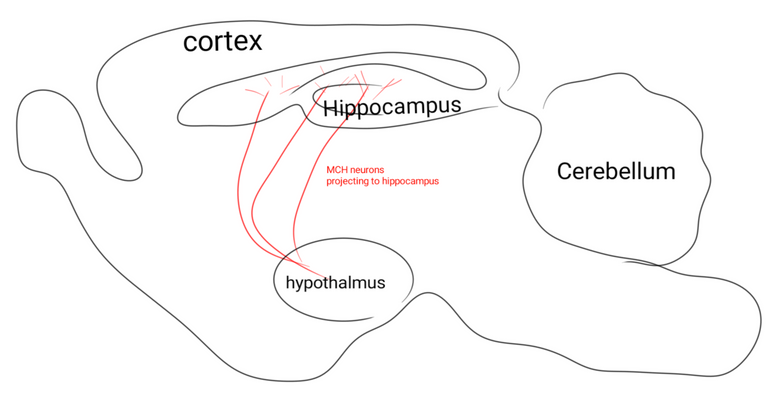 )
)
Now if you wanted to know which buttons are being pressed to regulate memory, you need to figure out which buttons are connected to the place where memories are being formed, recalled and replayed. One way to do this is to label the neurons which fire to this region. You can inject the brain of the mice with something called - retrogradely transported beads or retrobeads. The thing with these beads it that they will be transported back to neurons that make connections to the region they are injected in. Hence, by injecting these beads in the hippocampus Izawa et al., were able to find MCH neurons in the hypothalamus, among others projecting to the hippocampus.
Melanin-concentrating hormone (MCH) neurons are known for regulating exploring behaviour, feeding, mood and sleep (Blanco-centurion et al., 2019, Verret et al., 2003, Torterolo et al., 2015, Dilsiz et al., 2019). However, there isn't much to say about there role in the regulation of memory formation or retention.
Activating MCH neurons makes the mice forget.
Hence, to explore the possibility of their involvement in memory, the researcher used chemical and optogenetic tools to activate and inhibit MCH neurons. First, they created a MCH-Cre mouse. Then they injected that mice brain with an adeno associated virus (AAV) containing a FLEX-hM3Dq gene. This way hM3Dq protein is specifically expressed in MCH neurons. The thing about hM3Dq is that it a receptor that can be activated by a chemical called clozapine-N-
oxide. On activation, the receptor causes a release of calcium ions in the neurons and hence activates it.
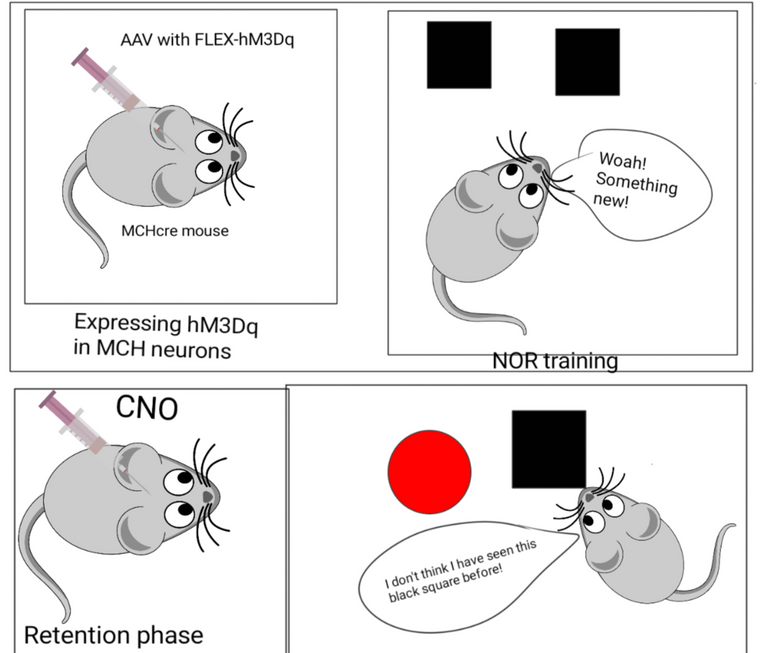
Mouse by Clker-Free-Vector-Images and syringe by janjf93 | Pixabay.
Illustrated by @scienceblocks using
Now all they needed to do was to teach the mice something and activate MCH neurons after the learning to see if the memory of the mice improves or worsens. To do so they put the mice in novel object recognition (NOR) test, and then gave it CNO during the reception period. During NOR test the mice are exposed to novel objects. Now, mice love novelty and spend most of its time exploring the novel objects. Then after some hours to days of retention period you expose the mice to the same object and even another novel object. If mice remember the previous object, it would spend less time with it. If it doesn't it would re-explore the old object as it did before (Lueptow, 2017).
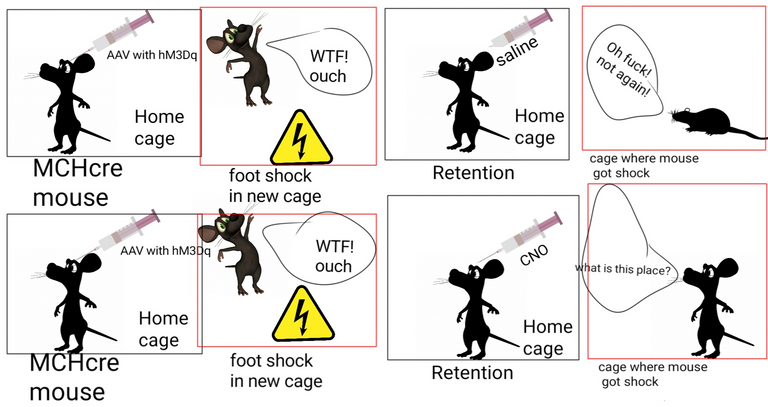
syringe by janjf93, scared mouse, and electrical danger by DavidRockDesign | Pixabay
Dancing mouse and normal mouse
| CC0 public domain
Illustrated by @scienceblocks using -
Izawa et al., found that if they activated MCH neurons by giving CNO to mice after exploring the novel object, the mice failed to remember it during the test. This also held true for context-dependent fear memories. The context-dependent fear memory is created by exposing the mice to a new cage and giving it a foot shock in the new cage. That way mouse learns to fear this new context. But if you activate the MCH neurons then it appeared that mice did not remember the new context so well.
Inhibiting or ablating MCH neurons enhances memory
Now, I remember this!
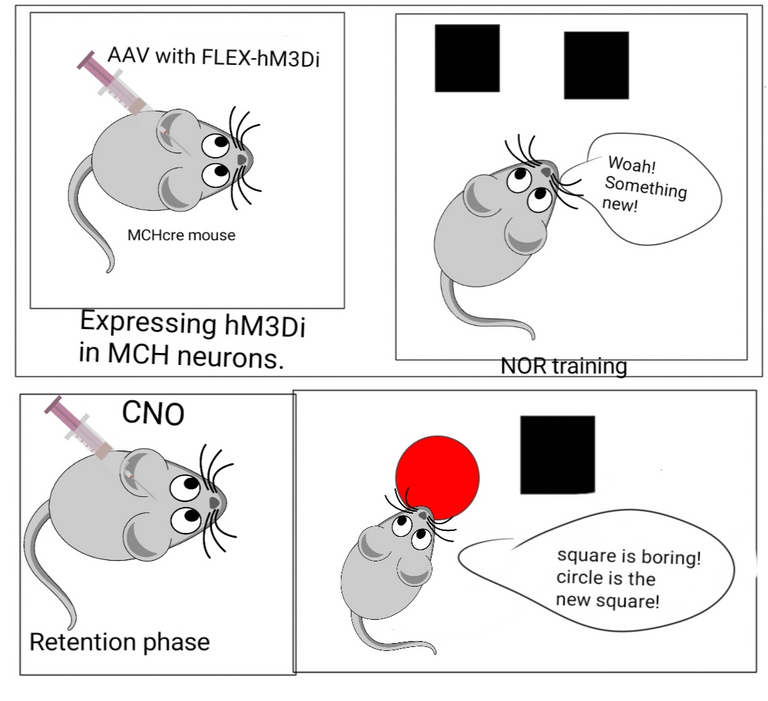
Mouse by Clker-Free-Vector-Images and syringe by janjf93 | Pixabay.
Illustrated by @scienceblocks using
Ideally, if activation of MCH neurons is required for forgetting then inhibiting them would enhance the memory. To test this hypothesis. The authors this time injected the MCH-cre mice with a virus contacting gene for FLEX-hM3Di. hM3Di protein now expressed in MCH neurons acts in a direction opposite to hM3Dq. Hence, on getting CNO injection MCH neurons will be inhibited. So what happened when after learning in NOR test the mice received CNO? Turns out it remembered things better. It even feared the context when it received shock more than the mice that got saline instead of CNO.
No MCH neurons - longer retention of memory.
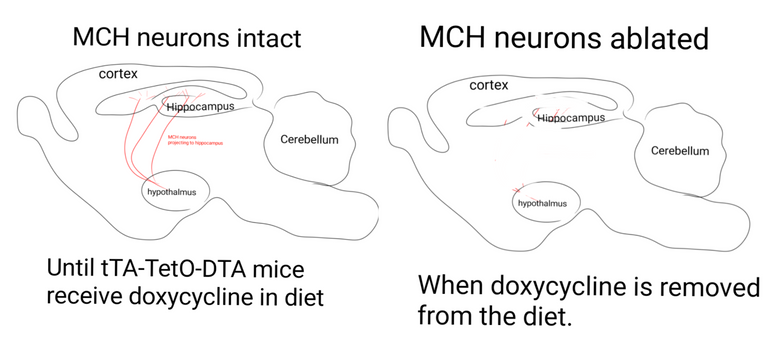
Inspiration used from image by Smittawiki | CC BY 3.0
Drawn by @scienceblocks
To see for how long will the mice retain the memory if MCH neurons did not fire, the authors genetically ablated the MCH neurons after a learning session. To do so they took a MCH-tTA mice and expressed diphtheria toxin A fragment (DTA) gene them under the control of TetO sequence. What happens here is that MCH neurons do not express DTA gene unless there is doxycycline in the diet of mice (because tTA protein can't bind to TetO sequence in presence of doxycycline). However, once doxycycline is removed from the diet, tTA binds to TetO, DTA gets expressed and kills the cells it is expressed in.
When Izawa et al., ablated the MCH neurons, the mice remembered the novel object it was exposed to for more than 48 hours. It was also more scared of the context where it received foot shock in. However, to see if forgetting MCH neurons only affected hippocampus based contextual memories the authors also conditioned the mice to be scared of a tone. In this scenario, the mice would hear a tone and right after the tone, it will receive a foot shock. This kind of fear memory comes majorly from the amygdala (another brain region). Hence, it wasn't surprising to see that ablation of MCH neurons did not improve tone dependent fear memory.
MCH neurons make mice forget only during retention phase.
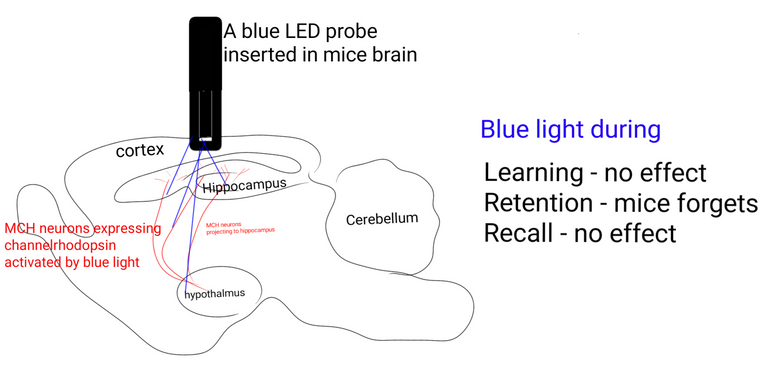
Inspiration used from image by Smittawiki | CC BY 3.0
Drawn by @scienceblocks
All this is fine, but you might want to ask, at what point after learning, is the activation of MCH neurons important for forgetting something? It would be nice if you can control exactly when the MCH neurons get activated. One way to do this by using optogenetics. That is to express the Channelrhodopsin in just MCH neurons and then inserting blue LED lights in the mice brain. Now you can shine the blue light, which will turn on the channelrhodopsin causing the MCH neurons to fire. And this is what researchers did. They activated the MCH neurons with blue light either during training or during retention period or during the final test. Only when the MCH neurons were activated during the retention period it led to forgetting memories. That is to say, MCH neurons did not play a role in learning and recall but it does something to memories probably when they are being replayed. So when do MCH neurons really fire during retention period?
Different MCH neurons fires during REM sleep and awake state.
To figure out when certain kind of neurons fire you need to label them in a way that they shine only when they are firing. One way to do this is by expressing a protein called GCaMP6 in cells of your interest. This protein is a calcium sensor. When a neuron fires the calcium concentration in its cytoplasm increases. This causes this protein to give out green light in response. To do this the authors injected virus contains FLEX-GCaMP6 gene in the brain of MCH-Cre mice. Now whenever the MCH neuron will fire it will shine green and fibre optics inserted in mice brain will record the cell that fired.
There was some activity of MCH neurons when mice were awake. But this activity increased further when the mice were sleeping. Especially during their REM sleep (the dream sleep). The activity was mainly quite high when mice went from NREM to REM sleep and NREM to wakefulness transitions. When they resolved the MCH neuron activity to a single cell state, the authors discovered that there are 3 sub-populations of MCH neurons. One that is active during wakefulness, another cluster active during sleep and a third small cluster active both during sleep and awake state. This indicates that MCH neurons might have a dedicated role during sleep - like deleting memories.
The MCH neurons thar are active during REM sleep are required for forgetting.
To check if the sleep active MCH neurons are indeed those that are required for forgetting, they had to inhibit these neurons when the mice were sleeping or awake. Then see which inhibition actually improves memory. To do so the authors expressed a protein called ArchT in MCH neurons of the mice. ArchT acts on direction opposite to that of channelrhodopsin. That is when turned on by yellow-green light, the ArchT inhibits the firing in neuron it is expressed in. The NOR test revealed that memories were improved only when MCH neurons were activated during REM sleep. Activating them during NREM sleep or during wakeful state had little to no effect.
Summary
Hence, the paper clearly demonstrates that the firing of MCH neurons during sleep is involved in forgetting memories. However, this makes me further curious to know what makes the MCH neurons fire. Like do they fire randomly or do certain kind of feedback from memory and reward systems control them? What I am saying is that if this is indeed one of the buttons of archivist now it boils down to knowing how and when this button is pressed.
There is one point to note in the study though. The MCH neuron activity is quite high during NREM to REM transition states. It is possible that by inhibiting these neurons we may be affecting the state itself. Authors do show that REM sleep time is affected by inhibiting these neurons. Hence, the study doesn't completely rule our other indirect mechanism for forgetting related to sleep state.
Nevertheless, this is still pretty cool. I mean if this is really how it works imagine what it means for therapy of those suffering from memory-related anxiety disorders like PTSD. Maybe, someday in future, it would be possible to give a drug to activate these neurons while someone is sleeping and make them forget specific memories by cues. Let's see.
If you have any questions or insights that I might have missed, do let me know in comments. Let me know if you enjoyed this journal club or if you would like something to be improved.
About steemstem
But, before I go I would like to mention about the steemstem platform. Well, if you love reading and writing interesting science articles @steemstem is a community on steem that support authors and content creators in the STEM field. If you wish to support steemstem do see the links below.
You can vote for steemstem witness here -Quick link for voting for the SteemSTEM Witness(@stem.witness)
Quick delegation links for @steemstem
50SP | 100SP | 500SP | 1000SP | 5000SP | 10000SP
Delegating to @steemstem gives an ROI of 65% of the curation rewards.
Also, if you have any questions regarding steemstem, do join the steemstem discord server.
You can DM me on discord, I have the same handle - @scienceblocks. Also if you are not a steem user, and reading this blog inspired you to start your science blog, find me on discord and let me know about you. I can try and help you navigate your way through steem.

References
Dream within a dream - Editing and inception of memories (Research Highlights)
Giri et al., 2019. Hippocampal Reactivation Extends for Several Hours Following Novel Experience
Schuck and Niv, 2019. Sequential replay of nonspatial task states in the human hippocampus.
Francis Crick & Graeme Mitchison, 1983. The function of dream sleep
Feld et al., 2017. Sculpting memory during sleep: concurrent consolidation and forgetting
Dilsiz et al., 2019. MCH neuron dependent reward and feeding.
Leuptow, 2017. Novel Object Recognition Test for the Investigation of Learning and Memory in Mice.
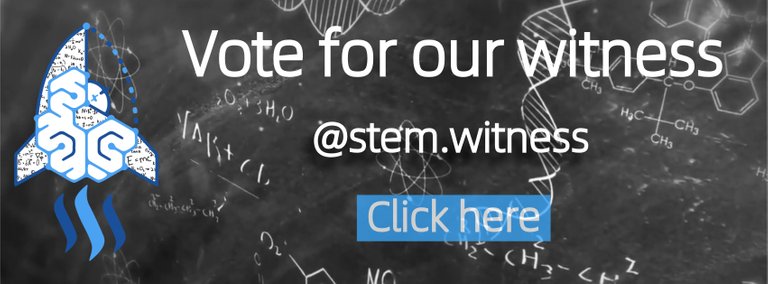
As usual, this was an amazing post to read! Thanks for putting all of this state-of-the-art research together! I liked to think about the credo of "Somehow, we need to forget to reinforce memorising new things better". Well, more or less... :)
Anyways, I however have one very real question. So far, we seem to understand better how memory works with mice and we can start playing with it. This is after all what Izawa et al. did. But how all of this can be transferred to normal mice, and further, to other beasts (including humans). Would it work strictly the same?
PS: I loved the name ‘MCH-Cre mouse’
PS2: the links at the end of the post look weird on steemstem.io but this will be fixed when I will deploy the new markdown/html converter. I just do not know when I will finish it (hopefully this week). If you want to fix it already know, it is important not to mix markdown and HTML together. You can use this piece of code for instance:
<a href="https://steemconnect.com/sign/account_witness_vote?approve=1&witness=stem.witness"> <img src="https://cdn.discordapp.com/attachments/354723995037466624/623491172400103424/Witness_Banner.jpg"> </a>I actually wrote two answers to your question. I will call it a short answer and a long answer.
Short answer : The way this could be transferred to other beasts would be to develop small molecule drugs that can activate/deactivate certain set of neurons to achieve the goal at hand. Example from Izawa et al would be a drug that is MCH agonist. People with say PTSD sleep after taking the drug. The therapist plays triggers that turn on the memory.
Long answer:
That's the thing you know, most of our knowledge about how biological things work is based either on looking at artificial systems (like cell culture), or animal models. Memory is just one of many processes we understand this way. It is sometime scary to look up papers on drugs that we take and see how much we know about them working in animals and how little we know of them working in humans.
But, then if you were editing or playing around with humans in way we do with animals we would have serious ethical issues. So we follow this principle that most biological processes are evolutionary conserved. The closer the species is to us on evolutionary timescale, less likely it would work different. Hence drugs go from understanding mechanism in mice to testing them in mice, then primates, and finally human trials.
Coming to memories. For a change it has been working pretty well in parallel with humans. For instance, the involvement of hippocampus in making new memories came from the famous HM patient. People with hippocampal injury get what is called retrograde amnesia. That is they remember old memories but can't form new memories. (They also have problems in imagining and planning future). Following these human findings mice helped a lot in understanding how hippocampus process memories. However the fact that old memories are intact also gave us hint that after initial memory formation the hippocampus sends the memory to other slow learning brain regions like cortex. Now this is where things get really interesting.
Humans have highly developed cortex compared to mice. And I won't be surprised if there drastic differences in what happens with memories here in mice vs humans. Then consolidation of memories in humans is on time scale of decade, mice don't even live that long. Sadly, we don't have many non invasive techniques to pin point the subtle differences, so it boils down to trial and error in humans from understanding gained in mice.
Some examples of mice helping in fixing human memory problems would be in therapies that uses extinction and replacement post recall in PTSD patients. Izawa et al., study has potential to yield a drug to aid in further improvement of such therapies. Will it work in humans? Time would tell.
Also, thanks for that code. I was struggling that why usual format markdown "[!image (link) ] (link) is not working.
Thanks for both the long and short answer. I was suspecting something close to what you said, but it is good to get the confirmation. From what you said, it is thus not impossible to see tests on humans (with memory issues maybe) soon in the future. Good to know (as it seems to work so well on mice).
Have a nice week-end!
PS: usual markdown will work with v1.17... But I still need to implement the treatment of tables in there.
I have enjoyed this article. It contains very complete and wide variety information that accredits it as an important publication for steemit.com users.
Thank you for sharing it with all of us!Hi @scienceblocks
This post has been voted on by the SteemSTEM curation team
and voting trail. It is elligible for support from @curie and @minnowbooster.
If you appreciate the work we are doing, then consider supporting our witness @stem.witness. Additional witness support to the curie witness would be appreciated as well.
For additional information please join us on the SteemSTEM discord and to get to know the rest of the community!
Thanks for having used the steemstem.io app and included @steemstem in the list of beneficiaries of this post. This granted you a stronger support from SteemSTEM.
This post was selected, voted and shared by the Natural Medicine Curation Team in collaboration with the C-Squared Curation Collective. Natural Medicine Curators are on the look out for natural health wisdoms, from herbs and essential oils to environmental health, spirituality, meditation and everything in between.
It has been upvoted and re-steemed by the @naturalmedicine and @c-squared accounts after manual review.
You can find more informative and inspiring natural health content on NaturalMedicine.io!
@C-squared is community curation group where everyone is a curator, actively working to support authors. Please consider @c-squared as your witness as a way to support this project.Hi @scienceblocks!
Your UA account score is currently 3.720 which ranks you at #5561 across all Steem accounts.
Your rank has not changed in the last three days.Your post was upvoted by @steem-ua, new Steem dApp, using UserAuthority for algorithmic post curation!
In our last Algorithmic Curation Round, consisting of 101 contributions, your post is ranked at #5.
Evaluation of your UA score:
Feel free to join our @steem-ua Discord server